Everything in your dog’s life is your decision. It’s a huge responsibility, and one we gladly shoulder because our dogs add so much to our lives. But everything to do with our dogs’ wellbeing is on us.
We all want the best for all of our family members – dogs included. One portion of that is seeing to their physical fitness. The training games we play keep them “on their toes” mentally. Some of those games involve physical exertion. Others are rather stationary. To make sure our dogs are “warmed up,” we do some warm-up exercises that include some basic stretches.
Every dog knows how to stretch, just like every dog knows how to sit. Getting them to do it on command takes a little training, but it’s easy for anyone familiar with training games.
Most dogs (and people!) stretch when they first wake up. When you see your dog stretching, say “good stretch!” and give him/her a treat. If your dog is accustomed to 2-Minute Training methods, he’s going to ask himself “What did I just do that got me that treat?” and he’ll try it again. It may take a few times for your dog to understand what’s being rewarded. Don’t worry about “catching” the stretch every time. Your dog stretched before he knew there was a name for it, and he’ll keep doing it whether or not you ask him.
Other stretches
The wake-up-from-a-nap stretch is an all-over, full-body stretch. There are also specific stretches to help your dog get moving. If you have an older dog, or one that may suffer from arthritis, these can be helpful as well. Pay attention to your dog – if he or she is resisting a particular movement, stop. Don’t force any movement. Our dogs have no way of telling us if something hurts – your first indicator may be resistance. The second may be a yipe of pain, which we want to avoid. Our purpose is to help our dogs keep moving. Pain isn’t any part of that.
Legs:
Before you start doing stretching exercises with your dog, take note of each joint in their legs and how they naturally move.
Dogs’ front leg joints are called the same as our arms: shoulder, elbow, wrist. But they don’t move the same as ours. Dog shoulders aren’t designed to “spread” their arms as we can – don’t ask them to. What we can do for the shoulder is gently, while supporting the elbow, move the fore leg back and forth. Don’t go sideways – dog shoulders don’t move that way. Same with the elbow and wrist – gently move them back and forth, copying the natural movement of the joint.
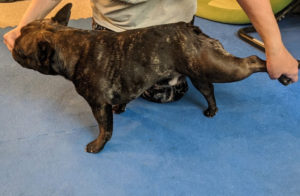
Rear leg extension 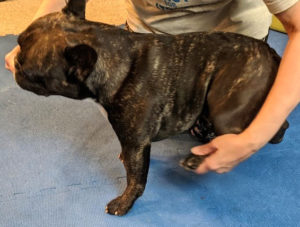
Rear leg flexion
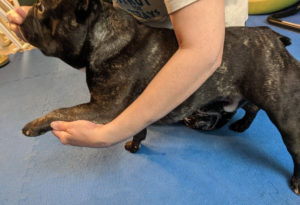
Front leg extension 
Front leg flexion
Dogs’ back leg joints, from top to floor are called hip, knee, and hock. Just the simple exercise asking your dog to “sit” alternately with “stand” will warm up the joints. You can also gently manipulate the joints, in the pattern of their natural movement, while your dog is standing still.
Neck:
Most people don’t think about dogs needing to stretch their necks, but keeping them limber is always a good thing. Dogs don’t seem to “roll their heads” around to stretch their necks, so they need some help. Again, never force any movement on your dog. If he’s unwilling to move a certain way, try again another time, perhaps with a lesser angle or degree of motion.
We generally don’t use “lures” to train dogs, but in this case it’s the easiest way to get your dog to stretch. While your dog is still, move a treat along from about his cheek back toward his shoulder. If you do it on both sides, it will stretch his neck to either side. To get the “up” and “down” sides, hold a treat above his head for the “up.” To get your dog to stretch his neck forward, have him stand and hold the treat between his front paws, with your finger pointing toward the dog’s head. You may have to get down on the floor to do it.
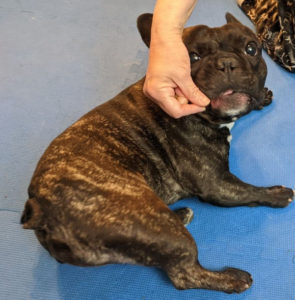
Neck stretch to the right 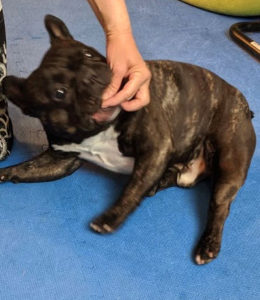
Neck stretch to the left

Neck stretch up 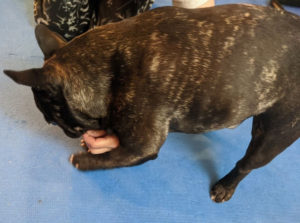
Neck stretch down
All stretched out
Of course you can make “stretches” another training game in your repertoire. Think of names you can remember for each of them, and, while you’re doing them, repeat the word with praise and treats. Hope’s French Bulldog Torque’s favorite “trick” – tapping alternately on her legs – started as front leg stretches. He loves doing it. And it makes her smile every single time.






